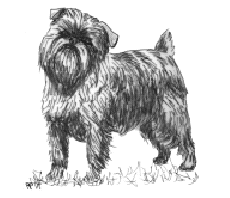Griffon Bruxellois
General Information - Griffon Bruxellois

Group:
Toy
Size:
Small (2.5kg-5.5kg)
Lifespan:
12-15 years
Exercise:
Moderate
Grooming:
Moderate
Trainability:
Moderate
Watchdog Ability:
Very high
Protection Ability:
Very low
Area of Origin:
Belgium
Date of Origin:
1800s
Other Names:
Brussels Griffon,
Belgian Griffon
Original Function:
Small vermin hunting,
companion
History
The Griffon Bruxellois was bred in Belgium for ratting and owes its existence to a number of breeds, including the Affenpinscher, Pug, Ruby King Charles Spaniel and Yorkshire Terrier. Around the 18th Century, the Griffon became popular with royalty and a breed club was formed in England, which is still active today. Griffon means rough coated, Bruxellois or Brussels is where they came from. The smooth variety was given the name Petite Brabacon, little smooth coat. Once kept by cab drivers of 17th-century Brussels to rid their stables of vermin, the Griffon Bruxellois became a companion breed by virtue of its appealing character.
Temperament
This charming and clever dog makes an excellent companion. A smart, cobby little dog who can be lively and alert, with the disposition of a terrier. They are robust, intelligent and easy to train, but can be determined. You need to earn their respect and work as a partnership, rather than trying to dominate them (or allowing them to dominate you). He has lots of personality, and attracts attention wherever he goes. He is very loyal to his owner.
Upkeep
The Griffon Bruxellois is an active breed, always on the lookout for action. He will enjoy a good walk, keeping up with you all the way. Some enjoy the challenge of agility training. He is a house dog, and enjoys snuggling up on the couch next to you. The rough coat needs combing 2/3 times a week, plus shaping by stripping, and a complete strip out twice a year, although pets can be clipped. Grooming for the smooth coat is minimal, consisting only of occasional brushing to remove dead hair. Toenails should be trimmed regularly.
Griffon Bruxellois
A breed standard is the guideline which describes the ideal characteristics, temperament, and appearance of a breed and ensures that the breed is fit for function with soundness essential. Breeders and judges should at all times be careful to avoid obvious conditions and exaggerations, as well as being mindful of features which could be detrimental in any way to the health, welfare or soundness of this breed.
Breed Standard - Griffon Bruxellois
 General Appearance:
General Appearance: A cobby, well:balanced, square little dog, giving appearance of measuring the same from withers to tail root as from withers to ground.
Characteristics: Smart little dog with disposition of a terrier. Two varieties, rough coated, Griffon Bruxellois and smooth coated, Petit Brabançon. Both with pert, monkey-like expression, heavy for size.
Temperament: Lively and alert.
Head and Skull: Head fairly large in comparison to body, rounded but in no way domed, moderately wide between the ears. Hair on skull, in roughs rather coarse. Nose black, with large wide-open nostrils and definite stop between muzzle and skull. Relatively short, wide muzzle, neat lips, with good turn-up. Chin prominent, in roughs furnished with beard.
Eyes: Black-rimmed, very dark, round, clear and well spaced. Moderately large; size should be in proportion to size of skull. Alert expression.
Ears: Semi-erect, high:set, the smaller the better.
Mouth: Slightly undershot with even teeth, not showing teeth or tongue.
Neck: Medium length, slightly arched, springing from well laid back shoulders.
Forequarters: Chest rather wide and deep, legs straight of medium length and bone.
Body: Short back, level from withers to tail root, neither roaching nor dipping; deep; well-sprung ribs; short, strong loin.
Hindquarters: Well muscled thighs of good length, hocks low to ground, turning neither in nor out, stifles well bent.
Feet: Small, thick, cat-like with black toenails.
Tail: Customarily docked.
Docked - Docked short, high set, emerging at right angles from level topline.
Undocked - High set, emerging at right angles from level topline. Of moderate length, curved gently over back when moving.
Gait/movement: Free with good drive from rear. Moving true coming and going. High stepping front movement undesirable.
Coat: Roughs - harsh, wiry, free from curl, preferably with undercoat.
Smooths - short and tight.
Colour: Clear red, black or black and rich tan without white markings. In clear red, a darker shade on mask and ears desirable. Ideally each hair should be an even red from tip to root. Frosting on muzzles of mature smooths should not be penalised.
Size: 3.2 - 5 kgs (7 - 11 lbs); most desirable 3.6 - 4.5 kgs (8 - 10 lbs).]
Faults: Any departure from the foregoing points should be considered a fault and the seriousness with which the fault should be regarded should be in exact proportion to its degree and its effect upon the health and welfare of the dog.
Note: Male animals should have two apparently normal testicles fully descended into the scrotum.
DNZ No 124
Copyright Dogs New Zealand
19 Dec 2013
Any departure from the foregoing points should be considered a fault and the seriousness with which the fault should be regarded should be in exact proportion to its degree and its effect upon the health and welfare of the dog and on the dog’s ability to perform its traditional work.




